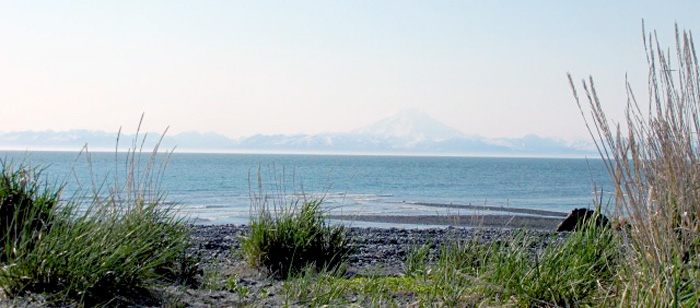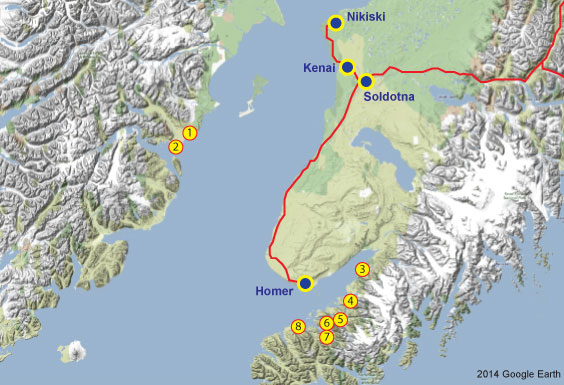
Check out our writeup: Razor Clamming Alaska's Cook Inlet by Mari Reeves
Remote, boat-accessible clamming opportunities exist across Kachemak Bay. Check out Halibut Cove, Sadie Cove, Jackalof Bay and others listed below.
CAUTION: Paralytic Shellfish Poisoning (PSP) has caused several deaths in Alaska. The Alaska Department of Fish & Game regularly tests and certifies certain beaches as PSP-free. Limit your clamming to these beaches to avoid the risk of PSP. The ONLY certified beaches in the state of Alaska are all in the Lower Cook Inlet / Kachemak Bay area, as follows: Polly Creek, Crescent River, Chugachik Island, Halibut Cove, Sadie Cove, Tutka Bay, Jackalof Bay and Kasitsna Bay (McDonald Spit).

Certified PSP-Free Beaches in Alaska
- Polly Creek: Requires fly-out from Anchorage, Kenai / Soldotna or Homer.
- Crescent River: Requires fly-out from Anchorage, Kenai / Soldotna or Homer.
- Chugachik Island: Requires fly-out from Homer or 16.5 mile boat run northwest of Homer boat harbor.
- Halibut Cove: Requires fly-out from Homer or 8.4 mile boat run west of Homer boat harbor.
- Sadie Cove: Requires 14-mile boat run southeast from Homer boat harbor. Clamming is at the head of the bay.
- Tutka Bay: Requires a 17.6-mile boat run southeast from Homer boat harbor. Clamming is at the head of the bay.
- Jackalof Bay: Requires a 13.6-mile run southeast from the Homer boat harbor. Clamming is at the head of the bay.
- Kasitsna Bay (McDonald Spit): Requires an 11.7-mile boat run south from Homer boat harbor. The most direct route is along the north side of Yukon Island, however in rougher weather a more sheltered route is to cut across Kachemak Bay and duck in behind Yukon Island via Eldred Passage to McDonald Spit. Clamming is in the flats between the spit and the mainland.

The above map shows the details of the locations of PSP-free beaches in Kachemak Bay. Note that in most cases the ideal clamming locations are at the head of the bays, where mud flats are exposed at low tide.
Supplies
Are you new to clamming in Alaska? You're in for a great time! Whether you're flying solo or taking the kids out for a weekend, clamming is a great way to enjoy the Alaska outdoors, and to harvest some delicious seafood at the same time. The tools needed are actually very simple. Here's a list:
- Alaska fishing license
- Clam shovel or clam gun
- Plastic five-gallon bucket
- Rubber gauntlet gloves
- Rubber boots
- Raingear, as needed
Cleaning Your Catch
Cleaning clams is time-consuming, but the rewards are great.
- Steamer clams: Steamers are filter feeders, and they usually ingest sand or mud from the area where they live. This grit has to be purged out of the clams, by allowing them to filter naturally in seawater. Simply fill a five-gallon plastic bucket about 1/2 to 3/4 full of seawater, depending on how many clams you have, and after rinsing the clams quickly to remove external grit, place them in the clean seawater. Avoid rapid temperature fluctuations or you could kill your clams. And forget about corn meal (some say corn meal helps the process, but clams don't filter corn meal). Let the clams purge for ten or more hours, changing your water as often as necessary. Once the clams are clean, prepare them as your recipe requires.
- Razor clams: Razors are very popular on Kenai Peninsula beaches, and they take a little work to prepare. Begin by placing the clams, one at a time, in boiling water. As soon as the shell pops open, immediately place the clam in very cold water to stop the cooking process. Remove the meat from the shell in one piece. Snip the brown end off of the siphon with scissors, and then open the siphon lengthwise with a small sharp knife. Note that the siphon has two parallel tubes, one under the other. Open both tubes up lengthwise. Remove the brownish-colored gills with scissors. Squeeze the foot (the digger) and make a circular cut to remove the stomach. The stomach contains a small clear rod that must also be removed. Slit the digger from one end to the other and remove the rest of the digestive system, which is pretty much anything else that is a brownish color. With the razor clam clean, it is ready to use in your favorite recipes.
Resources
If you plan to fish anywhere on the Kenai Peninsula, you need a copy of Dave Atcheson's "Fishing the Kenai Peninsula" in your rig. If you're new to the area, a copy of The Milepost will help you plan your trip, providing maps and detailed information on the locations of campgrounds, cabins, places to eat, fuel stops and much more. While you're in the bookstore, you might also check out our maps of Kachemak Bay State Park, Kenai River (includes only the middle and lower sections of the river, from Skilak Lake to the mouth), and the Northwestern Kenai Peninsula map, which includes only the areas around Kenai, Soldotna, Sterling, Kasilof, and Nikiski. These are road maps, but they also show campgrounds, fishing areas and available species. Finally, check out Scott Haugen's excellent book, "Bank Fishing for Steelhead and Salmon" for excellent tips that will work on the Kenai River, Deep Creek and other places on the Kenai Peninsula.
Species
Check out these species pages for the types of fish you may encounter on the Kenai Peninsula:
King Salmon | Pink Salmon | Red Salmon | Silver Salmon | Chum Salmon | Halibut | Hooligan | Lingcod | Pacific Cod | Rockfish | Salmon Shark | Grayling | Lake Trout | Pike | Rainbow Trout | Dolly Varden
Click on the following links to review angling opportunities in the various areas of the Kenai Peninsula.
Kenai Peninsula Fishing Intro | Upper Kenai Peninsula Fishing | Central Kenai Peninsula Fishing | Lower Kenai Peninsula Fishing | Kenai Peninsula Marine Fishery | Kenai Peninsula Clamming | Seward Saltwater Fishing | Seldovia Fishing










